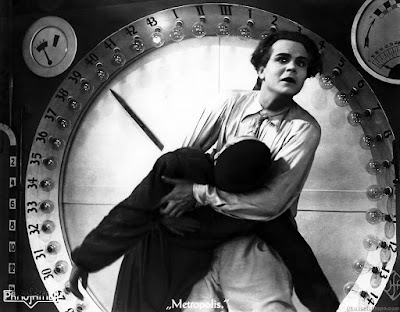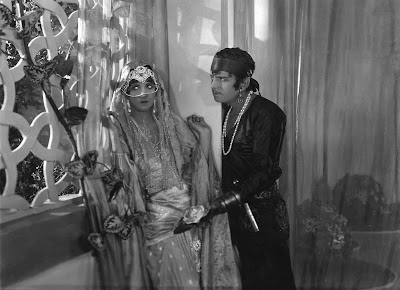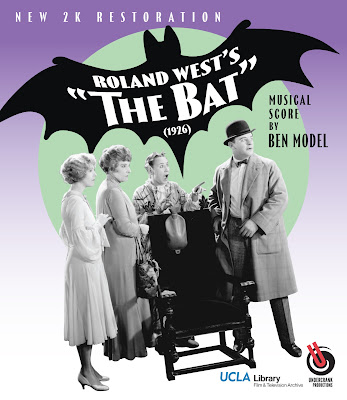This weekend takes me to the fair city of Cleveland, Ohio, where I'll accompany 'The Lost World' (1925) at this year's annual Sci-Fi Marathon at Case Western Reserve University.
It's the 50th annual edition of the Case Western Film Society's marathon, at which diehard movie buffs spend a mid-winter weekend watching sci-fi films of all types 30 to 36 hours non-stop.
And next month, I get to do music for a silent film at a similar event: the Boston Sci-Fi Marathon, also celebrating its 50th year on Presidents Day Weekend at the Somerville Theatre in Somerville, Mass.
The Boston folks have programmed an unusual title this time around: 'Algol: A Tragedy of Power' (1921), a German silent that I've never accompanied before.
I've done films at earlier editions of both marathons. What I love about them is that the audience is always so engaged. They may get into a "Mystery Science Theatre 3000" groove sometimes, but overall you won't find a more enthusiastic crowd than the sci-fi marathon audience.
If you're in the Cleveland area this weekend, I understand the Case Western marathon lets you buy tickets for individual screenings.
Although I encourage you to take in the experience in its entirety, if you'd like to attend just 'The Lost World,' it's scheduled to run on Saturday, Jan. 18 at 3 p.m. (Start time subject to change due to the ebb and flow of the marathon schedule.)
For more information about attending, check out the marathon's webpage.
Looking ahead: after a quiet start to 2025, things perk up with a cluster of screenings in late January and early February.
I'm accompanying 'Way Down East' (1920) on Sunday, Jan. 26 in Wilton, N.H.; 'Wild Orchids' (1929) on Wednesday, Jan. 29 in Manchester, N.H.; 'Straight is the Way (1921) in Campton, N.H.; 'The Flying Ace' (1921) on Sunday, Feb. 2 in Somerville, Mass.; and 'Nanook of the North' (1922) on Monday, Feb. 3 in Greenfield, Mass.
Hoping for a good turnout for 'Way Down East,' as I've found a crowded theater always helps the Griffith films "click" with modern audiences.
Seen in isolation, the early pioneering features directed by D.W. Griffith really seem to drag. But shown with an audience, they spring to life.
I think this has something to do with what Griffith did prior to the movies. For many years, he staged and directed melodramas for theatrical troupes that toured through small towns.
Back then, if you didn't entertain people, they'd throw things at you—or worse. So Griffith got very skilled at telling stories that would grab an audience early and then not let go.
I believe that more than anything else, this was Griffith's superpower: to be able tell a story in such a way that an audience can't stop watching.
Find out for yourself by being part of the experience when I accompany 'Way Down East' later this month at the Town Hall Theatre in Wilton, N.H. More details in the press release pasted in below.
* * *
MONDAY, JAN. 6, 2025 / FOR IMMEDIATE RELEASE
Contact Jeff Rapsis • (603) 236-9237 • jeffrapsis@gmail.com
Silent film classic 'Way Down East' at Town Hall Theatre on Sunday, Jan. 26
D.W. Griffith blockbuster starring Lillian Gish, filmed partly in New England, to be screened with live music
WILTON,
N.H. — The iconic image of actress Lillian Gish trapped on an ice floe
and headed straight for a waterfall will once again fill the big screen
when 'Way Down East' (1920) is revived on Sunday, Jan. 26, 2025 at 2 p.m.
at the Town Hall Theatre, 40 Main St., Wilton, N.H.
Live musical scoring will
be provided by silent film accompanist Jeff Rapsis. Admission is free;
donations are accepted, with $10 per person suggested to defray
expenses.
The
movie, a blockbuster melodrama directed by D.W. Griffith, is set in
old-time rural New England, and was partly filmed on location in New
Hampshire and Vermont. It stars Gish in an acclaimed performance as a
wronged woman trying to make her way in an unforgiving world. Can she
find love and redemption, or will she ride to her doom on the raging
river's ice floes?
In 'Way Down East,' Gish stars as a poor New England
country girl who travels to Boston to visit her rich relatives in the
hopes of getting financial help. While there, she's dazzled by upper
class society and romanced by a rich womanizer (Lowell Sherman) who
takes advantage of her innocence by tricking her into bed with a fake
marriage ceremony.
Convinced she's found the husband of her
dreams, Gish returns home to the country, only to be abandoned. She
informs her faux husband she's pregnant; he orders her to get an
abortion. Instead, Gish goes into exile to have the baby, finds herself
persecuted for giving birth out of wedlock, and flees into
the rural countryside to seek refuge. The film was noteworthy in its time for
addressing such topics as abortion and women's rights.
Modern
critics hail 'Way Down East' for Gish's performance, which continues to
mesmerize audiences nearly a century after the film's release. "Gish
provides an abject lesson in screen acting and brings home the
importance and effectiveness of seeing a film in a theater with a
crowd," wrote Paul Brenner on www.filmcritic.com
in 2007. "If you are not moved at the scene of Gish baptizing her dead
baby, then you should check the obituaries of your local paper to see if
you are listed."
The film also stars silent era heartthrob
Richard Barthelmess. In the film's climax, Barthelmess must dash to
rescue Gish from being carried away on the ice floes.
Much of the
acclaimed ice floe sequence was filmed in March 1920 on location on the
Connecticut River in New Hampshire and the White River in Vermont, as
the winter pack ice was breaking up. No process shots or post-production
special effects were available to filmmakers at the time, so Griffith
and his crew had no choice but to stage and shoot it all on a real
river, with the players out on the ice. To get the floes to break up and
float down the river, Griffith's crew dynamited pack ice upstream.
Gish
later said that she suffered frostbite by following director Griffith's
command to always keep one hand in the water during the shooting.
Despite
such hardships, 'Way Down East' cemented Gish's reputation as one of
the silent era's major stars. Gish would continue to work in films and,
later, television, until the 1980s. She died in 1993 at age 99.
Accompanist
Jeff Rapsis specializes in creating music that bridges the gap between
an older film and the expectations of today's audiences. Using a digital
synthesizer that recreates the texture of a full orchestra, he
improvises scores in real time as a movie unfolds, so that the music for
no two screenings is the same.
"It's kind of a high wire act,
but it helps create an emotional energy that's part of the silent film
experience," Rapsis said. "It's easier to follow the emotional line of
the movie and the audience's reaction when I'm able to follow what's on
screen, rather than be buried in sheet music," he said.
Because
silent films were designed to be shown to large audiences in theaters
with live music, the best way to experience them is to recreate the
conditions in which they were first shown, Rapsis said.
"Films
such as 'Way Down East' were created to be shown on the big screen to
large audiences as a communal experience," Rapsis said. "With an
audience and live music, silent films come to life in the way their
makers intended. Not only are they entertaining, but they give today's
audiences a chance to understand what caused people to first fall in
love with the movies."
'Way Down East' was based on a popular stage drama, for which director Griffith paid the then-astounding sum of $175,000 to turn into a movie. The picture proved to be a huge moneymaker, taking in $4.5 million, making it the fourth-highest grossing movie of the silent film era.
'Way Down East' would be the last
of Griffith's great blockbusters; tastes changed as the 1920s rolled on
and Griffith's Victorian style fell out of favor. Receipts from 'Way
Down East' kept Griffith's studio afloat during a subsequent series of
box office flops.
"This picture was a monster hit when it was
released," Rapsis said, "and it still holds up well today. As a
melodrama, it's a great film for an audience to cheer on the good folks
and boo and hiss the bad guys. But there's an additional level of
interest now because the film captured a way of life that's long since
disappeared."
'Way Down East' will be shown with live music on Sunday, Jan. 26
at 2 p.m. at the Town Hall Theatre, 40 Main St., Wilton, N.H.
Admission is free; donations are accepted, with $10 per person suggested
to defray expenses. For more information, call the theater at (603)
654-3456.




































